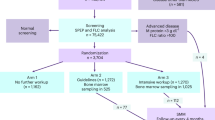Abstract
We studied the medical histories of 127 patients diagnosed with multiple myeloma included in a population-based registry of 945 patients with a paraprotein or multiple myeloma in the region of the Comprehensive Cancer Center West (CCCW). We defined patients “not immediately diagnosed” or “delayed diagnosis” as those patients in whom myeloma was not included in the initial differential diagnosis. We found that 37% belonged to this category. These patients more often had symptoms not associated with multiple myeloma. Since a surprising 51% of patients with delayed diagnosis turned out to have stage-Ill myeloma, the physician should be alert to the presence of this disease, despite the fact that co-morbidity may mask its presence.
Similar content being viewed by others
References
Alexanian R, Dimopoulos M (1994) The treatment of multiple myeloma. N Engl J Med 330:484–489
Dimopoulos MA, Moulopoulos A, Delasalle K, Alexanian R (1993) Solitary plasmacytoma of bone and asymptomatic multiple myeloma. Hematol Oncol Clin North Am 6:359–369
Dimopoulos MA, Moulopoulos A, Smith T, Delasalle KB, Alexanian R (1993) Risk of disease progression in asymptomatic multiple myeloma. Am J Med 94:57–61
Durie BGM (1986) Staging and kinetics of multiple myeloma. Semin Oncol 13:300–309
Durie BGM, Salmon SE (1975) A clinical staging system for multiple myeloma: correlation of measured myeloma cell mass with presenting clinical features, response to treatment, and survival. Cancer 36:842–854
Greipp PR (1992) Advances in the diagnosis and management of myeloma. Semin Hematol 29:24–45 [Suppl 2]
Kyle RA (1991) Plasma cell proliferative disorders. In: Hoffmann et al. (eds) Hematology: basic principles and practice. Churchil Livingstone, New York, pp 1021–1035
Kyle RA, Greipp PR (1988) Plasma cell dyscrasias: current status. Crit Rev Oncol Hematol 8:93–152
Ong F, Hermans J, Noordijk EM, Kluin-Nelemans JC (1995) Is the Durie and Salmon diagnostic classification system for plasma cell dyscrasias still the best choice? Application of three classification systems to a large population-based registry of paraproteinemia and multiple myeloma. Ann Hematol 70:19–24
Salmon SE, Cassady JR (1989) Plasma cell neoplasms. In: De Vita VT jr, Hellman S, Rosenberg SA (eds) Cancer: principles and practice of oncology, 3rd edn. Lippincott, Philadelphia, pp 1853–1888
Ucci G, Riccardi A, Luoni R, Ascari E, for the cooperative group for the study and treatment of multiple myeloma (1993) Presenting features of monoclonal gammopathies: an analysis of 684 newly diagnosed cases. J Intern Med 234:165–173
Author information
Authors and Affiliations
Rights and permissions
About this article
Cite this article
Ong, F., Hermans, J., Noordijk, E.M. et al. Presenting signs and symptoms in multiple myeloma: High percentages of stage III among patients without apparent myeloma-associated symptoms. Ann Hematol 70, 149–152 (1995). https://doi.org/10.1007/BF01682035
Received:
Accepted:
Issue Date:
DOI: https://doi.org/10.1007/BF01682035




